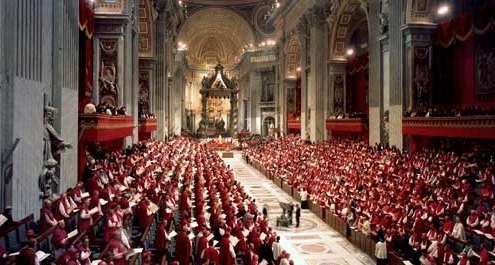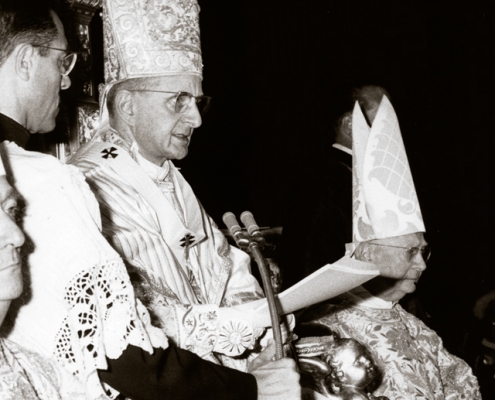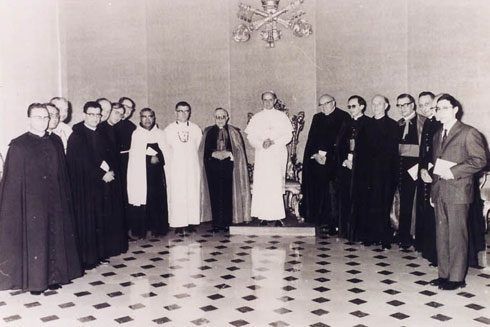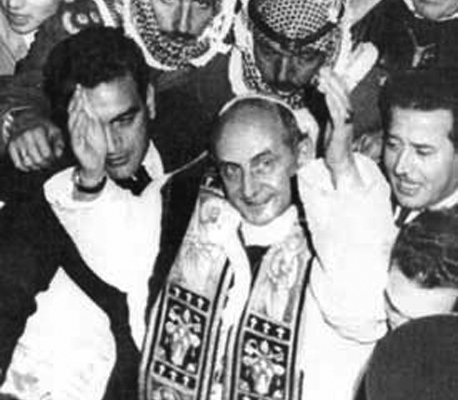Nostra Aetate: The Leaven of Good
The Film
In 2015, to mark the 50th anniversary of the declaration Nostra Aetate, the Pontifical Council for Interreligious Dialogue released a film, Nostra Aetate: The Leaven of Good, Part III, to explain the meaning of the important document that inaugurated the Catholic Church’s official interreligious dialogue.
Part II of the film, released in 2017, tells the story of the development of interreligious dialogue since 1965 with interviews and footage of events through the years. The films feature members of various world religions as well as persons in the Catholic Church who have engaged in interreligious dialogue.
Part III of Nostra Aetate film
Part II of Nostra Aetate film
Nostra Aeate Film Video Archives from Georgetown University
Nostra Aetate: The Foundational Document
Nostra Aetate, Latin for “In our Age,” are the first words of a groundbreaking document from the Roman Catholic Church’s Second Vatican Council, held from 1962 to 1965.
With this declaration, approved in 1965, the Church formally opened a wider dialogue with followers of other religions. Nostra Aetate provides guiding principles for the Pontifical Council for Interreligious Dialogue and all Catholic engaged in dialogue with followers of other religions.
During his address marking the 50th anniversary of the declaration, Pope Francis said, “Dialogue based on confident respect can bring seeds of good that in their turn may bud into friendship and cooperation in many fields, especially in service to the poor, to the least, to the elderly, through welcoming migrants, and attention to those who are excluded. We can walk together taking care of one another and of creation. All believers of every religion. ”
Nostra Aetate is available in 15 languages on the Vatican website.
DECLARATION ON
THE RELATION OF THE CHURCH TO NON-CHRISTIAN RELIGIONS
NOSTRA AETATE
PROCLAIMED BY HIS HOLINESS
POPE PAUL VI
ON OCTOBER 28, 1965
1. In our time, when day by day mankind is being drawn closer together, and the ties between different peoples are becoming stronger, the Church examines more closely her relationship to non-Christian religions. In her task of promoting unity and love among men, indeed among nations, she considers above all in this declaration what men have in common and what draws them to fellowship.
One is the community of all peoples, one their origin, for God made the whole human race to live over the face of the earth.(1) One also is their final goal, God. His providence, His manifestations of goodness, His saving design extend to all men,(2) until that time when the elect will be united in the Holy City, the city ablaze with the glory of God, where the nations will walk in His light.(3)
Men expect from the various religions answers to the unsolved riddles of the human condition, which today, even as in former times, deeply stir the hearts of men: What is man? What is the meaning, the aim of our life? What is moral good, what is sin? Whence suffering and what purpose does it serve? Which is the road to true happiness? What are death, judgment and retribution after death? What, finally, is that ultimate inexpressible mystery which encompasses our existence: whence do we come, and where are we going?
2. From ancient times down to the present, there is found among various peoples a certain perception of that hidden power which hovers over the course of things and over the events of human history; at times some indeed have come to the recognition of a Supreme Being, or even of a Father. This perception and recognition penetrates their lives with a profound religious sense.
Religions, however, that are bound up with an advanced culture have struggled to answer the same questions by means of more refined concepts and a more developed language. Thus in Hinduism, men contemplate the divine mystery and express it through an inexhaustible abundance of myths and through searching philosophical inquiry. They seek freedom from the anguish of our human condition either through ascetical practices or profound meditation or a flight to God with love and trust. Again, Buddhism, in its various forms, realizes the radical insufficiency of this changeable world; it teaches a way by which men, in a devout and confident spirit, may be able either to acquire the state of perfect liberation, or attain, by their own efforts or through higher help, supreme illumination. Likewise, other religions found everywhere try to counter the restlessness of the human heart, each in its own manner, by proposing “ways,” comprising teachings, rules of life, and sacred rites. The Catholic Church rejects nothing that is true and holy in these religions. She regards with sincere reverence those ways of conduct and of life, those precepts and teachings which, though differing in many aspects from the ones she holds and sets forth, nonetheless often reflect a ray of that Truth which enlightens all men. Indeed, she proclaims, and ever must proclaim Christ “the way, the truth, and the life” (John 14:6), in whom men may find the fullness of religious life, in whom God has reconciled all things to Himself.(4)
The Church, therefore, exhorts her sons, that through dialogue and collaboration with the followers of other religions, carried out with prudence and love and in witness to the Christian faith and life, they recognize, preserve and promote the good things, spiritual and moral, as well as the socio-cultural values found among these men.
3. The Church regards with esteem also the Moslems. They adore the one God, living and subsisting in Himself; merciful and all- powerful, the Creator of heaven and earth,(5) who has spoken to men; they take pains to submit wholeheartedly to even His inscrutable decrees, just as Abraham, with whom the faith of Islam takes pleasure in linking itself, submitted to God. Though they do not acknowledge Jesus as God, they revere Him as a prophet. They also honor Mary, His virgin Mother; at times they even call on her with devotion. In addition, they await the day of judgment when God will render their deserts to all those who have been raised up from the dead. Finally, they value the moral life and worship God especially through prayer, almsgiving and fasting.
Since in the course of centuries not a few quarrels and hostilities have arisen between Christians and Moslems, this sacred synod urges all to forget the past and to work sincerely for mutual understanding and to preserve as well as to promote together for the benefit of all mankind social justice and moral welfare, as well as peace and freedom.
4. As the sacred synod searches into the mystery of the Church, it remembers the bond that spiritually ties the people of the New Covenant to Abraham’s stock.
Thus the Church of Christ acknowledges that, according to God’s saving design, the beginnings of her faith and her election are found already among the Patriarchs, Moses and the prophets. She professes that all who believe in Christ-Abraham’s sons according to faith (6)-are included in the same Patriarch’s call, and likewise that the salvation of the Church is mysteriously foreshadowed by the chosen people’s exodus from the land of bondage. The Church, therefore, cannot forget that she received the revelation of the Old Testament through the people with whom God in His inexpressible mercy concluded the Ancient Covenant. Nor can she forget that she draws sustenance from the root of that well-cultivated olive tree onto which have been grafted the wild shoots, the Gentiles.(7) Indeed, the Church believes that by His cross Christ, Our Peace, reconciled Jews and Gentiles. making both one in Himself.(8)
The Church keeps ever in mind the words of the Apostle about his kinsmen: “theirs is the sonship and the glory and the covenants and the law and the worship and the promises; theirs are the fathers and from them is the Christ according to the flesh” (Rom. 9:4-5), the Son of the Virgin Mary. She also recalls that the Apostles, the Church’s main-stay and pillars, as well as most of the early disciples who proclaimed Christ’s Gospel to the world, sprang from the Jewish people.
As Holy Scripture testifies, Jerusalem did not recognize the time of her visitation,(9) nor did the Jews in large number, accept the Gospel; indeed not a few opposed its spreading.(10) Nevertheless, God holds the Jews most dear for the sake of their Fathers; He does not repent of the gifts He makes or of the calls He issues-such is the witness of the Apostle.(11) In company with the Prophets and the same Apostle, the Church awaits that day, known to God alone, on which all peoples will address the Lord in a single voice and “serve him shoulder to shoulder” (Soph. 3:9).(12)
Since the spiritual patrimony common to Christians and Jews is thus so great, this sacred synod wants to foster and recommend that mutual understanding and respect which is the fruit, above all, of biblical and theological studies as well as of fraternal dialogues.
True, the Jewish authorities and those who followed their lead pressed for the death of Christ;(13) still, what happened in His passion cannot be charged against all the Jews, without distinction, then alive, nor against the Jews of today. Although the Church is the new people of God, the Jews should not be presented as rejected or accursed by God, as if this followed from the Holy Scriptures. All should see to it, then, that in catechetical work or in the preaching of the word of God they do not teach anything that does not conform to the truth of the Gospel and the spirit of Christ.
Furthermore, in her rejection of every persecution against any man, the Church, mindful of the patrimony she shares with the Jews and moved not by political reasons but by the Gospel’s spiritual love, decries hatred, persecutions, displays of anti-Semitism, directed against Jews at any time and by anyone.
Besides, as the Church has always held and holds now, Christ underwent His passion and death freely, because of the sins of men and out of infinite love, in order that all may reach salvation. It is, therefore, the burden of the Church’s preaching to proclaim the cross of Christ as the sign of God’s all-embracing love and as the fountain from which every grace flows.
5. We cannot truly call on God, the Father of all, if we refuse to treat in a brotherly way any man, created as he is in the image of God. Man’s relation to God the Father and his relation to men his brothers are so linked together that Scripture says: “He who does not love does not know God” (1 John 4:8).
No foundation therefore remains for any theory or practice that leads to discrimination between man and man or people and people, so far as their human dignity and the rights flowing from it are concerned.
The Church reproves, as foreign to the mind of Christ, any discrimination against men or harassment of them because of their race, color, condition of life, or religion. On the contrary, following in the footsteps of the holy Apostles Peter and Paul, this sacred synod ardently implores the Christian faithful to “maintain good fellowship among the nations” (1 Peter 2:12), and, if possible, to live for their part in peace with all men,(14) so that they may truly be sons of the Father who is in heaven.(15)
________________________________________
NOTES
1. Cf. Acts 17:26
2. Cf. Wis. 8:1; Acts 14:17; Rom. 2:6-7; 1 Tim. 2:4
3. Cf. Apoc. 21:23f.
4. Cf 2 Cor. 5:18-19
5. Cf St. Gregory VII, letter XXI to Anzir (Nacir), King of Mauritania (Pl. 148, col. 450f.)
6. Cf. Gal. 3:7
7. Cf. Rom. 11:17-24
8. Cf. Eph. 2:14-16
9. Cf. Lk. 19:44
10. Cf. Rom. 11:28
11. Cf. Rom. 11:28-29; cf. dogmatic Constitution, Lumen Gentium (Light of nations) AAS, 57 (1965) pag. 20
12. Cf. Is. 66:23; Ps. 65:4; Rom. 11:11-32
13. Cf. John. 19:6
14. Cf. Rom. 12:18
15. Cf. Matt. 5:45




